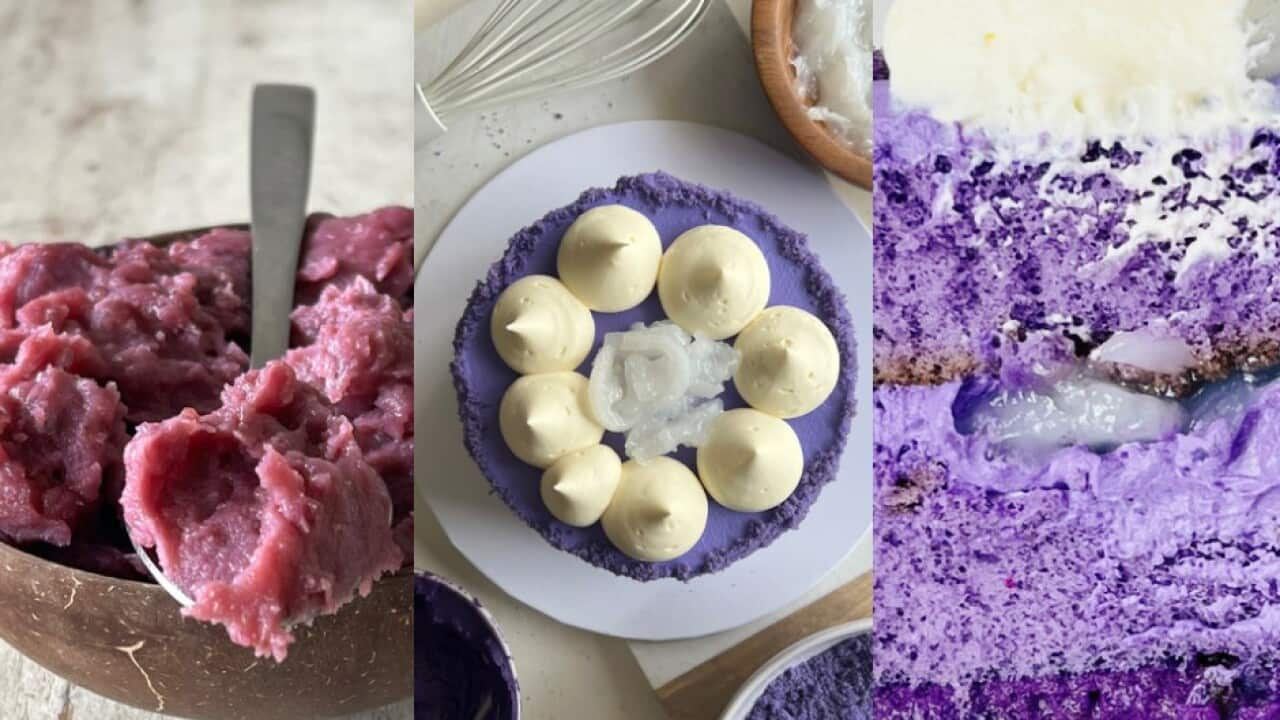Key Points
- Ube, known for its vibrant purple hue and rich flavor, has long been a symbol of Filipino desserts.iconic Good Shepherd brand from Baguio unveiled a white version of its famous ube jam.
- In 2019, the iconic Good Shepherd brand from Baguio unveiled a white version of its famous ube jam.
- There are 100 varieties of ube in the Philippines, with colorus ranging from deep purple to white.
LISTEN TO

Kwentong Palayok: Ang “ube-lievable” journey ng ube
SBS Filipino
27/09/202417:49
Ube, known for its vibrant purple hue and rich flavor, has long been a symbol of Filipino desserts, particularly in the form of the beloved ube halaya.
However, in 2019, the iconic Good Shepherd brand from Baguio unveiled a white version of its famous ube jam.
“Yes, it is ube jam, from white ube. Yes, there is such a thing. And yes it is just as good as the purple one,” Good Shepherd explained in a Facebook post.

Sister Marcia Mercado of the Religious of the Good Shepherd takes a spoonful of the Good Shepherd white ube jam. Credit: Religious of the Good Shepherd
Our ube farmers are having difficulty growing ube. Finding a stable supply has been a struggle in recent years.”Religious of the Good Shepherd Facebook
Instead of halting production altogether, Good Shepherd decided to work with what was available, using white ube to create the same delicious jam.
The main difference, explained Sister Guadalupe Bautista, manager and trustee at the Religious of Good Shepherd, a social enterprise in the Cordillera region, is the colour, and the consistency of the texture: the white ube is stickier than the purple one.
Besides climate change, the announcement from Good Shepherd revealed to many Filipinos that there are many different kinds of ube. There are 100 varieties of ube in the Philippines, with colorus ranging from deep purple to white.
According to the Philippine National Seed Industry Council, the most popular variants of ube are Basco ube (whose cortex has a white purplish tinge), Zambales ube (purple cortex), Leyte ube (cream to pink to white) and Kinampay (vibrant purple color, more market demand due to even shape and color).
Both white and purple ube (scientific name Dioscorea alata) are typically grown from March to May, with harvests occurring from June to September. However, climate-related factors such as temperature fluctuations and unpredictable weather patterns threaten the yields of this prized root crop.
Fewer trees and the removal of coexisting vegetation that provides natural shade can lead to diminished yam production, especially in uncontrolled environments.Project GUHeat Facebook
Project GUHeat focuses on urban heat assessments in Philippine cities.
“To mitigate the ongoing supply shortage of ube and other valuable crops, we must protect our farms, prevent land cover conversion, and reduce our carbon footprints that contribute to climate variability.”
Additionally, the growing global demand for ube has exacerbated the shortage. Recent data from the Philippines Department of Agriculture and the Bureau of Agricultural Statistics indicate that ube production plummeted from 30,074 metric tons in 2006 to just 13,957 metric tons in 2020.
The "ube-lievable" journey of this root crop was further explored in a recent episode of the Kwentong Palayok podcast, tracing its rise from humble beginnings to global fame. In fact, ube has been named the flavor of the year for 2024, according to the annual Food and Beverage Trends Report.
As the Philippines grapples with the climate crisis, Good Shepherd’s white ube jam has sparked a crucial conversation about the challenges facing ube production and the far-reaching impacts of environmental changes on this cherished ingredient.










